Catherine Astolfo's Blog, page 15
December 6, 2012
LIZ BUGG and THE NEXT BIG THING
My friend Liz tagged me recently for The Next Big Thing, but I went away and everyone I know seems to be taken! If you read this and are an author and want to participate, let me know.
I really, really like both Liz's and Robin's series, so I have copied (with permission) all of Liz's blog. Check out the authors listed at the end!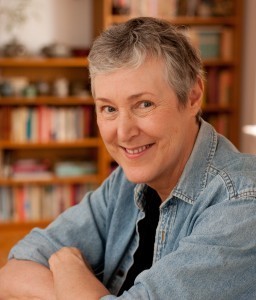 LIZ BUGG and THE NEXT BIG THING
LIZ BUGG and THE NEXT BIG THING
Every day there seem to be new promotional ideas for authors. Some aren’t worth the time, effort and money involved. One opportunity, however, recently tapped me on the shoulder, and I felt it was too good to ignore. Robin Spano, author of the Clare Vengel Undercover Novels, asked if she could tag me in The Next Big Thing. I agreed. A reciprocal tag then occurred with writer and artist Uvi Poznansky, http://uviart.blogspot.ca/.
Here’s how it works: It’s kind of like a chain letter with interview questions. Once you have been tagged by an author, you find five other authors who agree to be tagged by you. Then you write a blog entry in which you answer the questions about your next book and give links to the sites of the people you tagged. It’s that simple.
This is my first opportunity to talk about my new novel, so it should be fun. I wish I had a cover design to show you, but it’s not yet available.
Questions & Answers:
1. What is the working title of your book?
I’m now on my third working title, Yellow Vengeance. Only time will tell if it sticks.
2. Where did the idea come from for the book?
Since the novel is part of a series, the main characters are continuing along with their personal lives, based on what was introduced in previous books. As far as the mystery goes, I’ve always had an interest in the past and in cold cases, and this seemed to be the time to explore those areas in a novel.
3. What genre does your book fall under?
It is technically a mystery, but as always, I hope it goes beyond the solving of the crime to examine particular aspects of the society in which it is set as well as the human condition in more general terms.
4. Which actors would you choose to play your characters in a movie rendition?
For me, this is the hardest question. I have always been able to visualize my characters, but they have ever been based on particular actors or people I know. I actually had to do research for this – kind of a virtual casting call. In the end, I managed to narrow it down to a couple of possibilities for each. I’m still not totally happy with my Calli options; that’s why I’ve included three names. The casting of June was by far the easiest, and I would be happy with either actor.
Calli: Chloe Sivegny, Jodie Foster, Keeley Hawes
Jess: Michelle Krusiec, Sandrine Holt
Dewey: Darryl Stephens, Jeffrey D. Sams
June: Jessica Capshaw, Amy Carlson
Sashi: Sarita Choudhury, Veena Sood
5. What is the one-sentence synopsis of your book?
When someone steps out of Calli’s past and hires her to solve a cold case that even the police have abandoned, it leads to personal tragedy, just at the moment her life seems to be coming together.
6. Will your book be self-published or represented by an agency?
My book will be represented by P.S. Literary Agency and published by Insomniac Press in April of 2013.
7. How long did it take you to write the first draft of your manuscript?
I wrote the first draft on a part-time basis over about six months.
8. What other books would you compare this story to within your genre?
As far as the ‘story’ goes, I’m not aware of other books to which I could compare it. Looking at the book as a whole, one could, of course, draw comparisons to the first two novels in the series: Red Rover and Oranges and Lemons. Aside from those, one might find similarities to some of the novels of writers like Ellen Hart, Sara Paretsky or Sandra Scoppettone. I do try, however, to achieve something a little different from other books in the genre through my treatment of current issues, character development and tone.
9. Who or what inspired you to write this book?
The most important inspiration, if you can call it that, was my commitment to write a third novel in the Calli Barnow Series. Other than that, I wanted to explore areas of life to which I have a personal connection on some level. I won’t go into detail, because I don’t want to give away too much.
10. What else about your book might pique the reader’s interest?
If you like a mystery story narrated by a very human character, incorporating comedy, danger and personal tragedy, you will probably enjoy Yellow Vengeance.
That’s all I have to say about my upcoming novel, but if you’d like to find out about other future releases, please visit these great writers and see what they have for you:
Glynis Smy Glynis is the author of the historical romance, Ripper My Love,and writes for newspapers in Cyprus and the U.K. She also runs the wonderful New Book Blogger website.
Catherine Astolfo Catherine is the author of the Emily Taylor Series of mystery novels. In 2012 she won the Arthur Ellis Best Crime Short Story and the Derrick Murdoch Award for outstanding contribution to Crime Writers of Canada.
Suzanne Sutherland Suzanne’s short fiction has appeared in magazines such as Descant, Dragnet and Steel Bananas. Her first novel, When We Were Good, will be published by Sumach Press in 2013.
Bev Prescott Bev is an environmental attorney, previously enlisted in the U.S. Air Force. Her debut novel, My Soldier Too, was published by Blue Feather Books in 2011.
Uvi Poznansky Besides being an accomplished architect, Uvi is an artist and a writer with a diverse body of work. Her most recent publication, Home, is a tribute to her father and cannot be adequately described in this limited space.

I really, really like both Liz's and Robin's series, so I have copied (with permission) all of Liz's blog. Check out the authors listed at the end!
 LIZ BUGG and THE NEXT BIG THING
LIZ BUGG and THE NEXT BIG THINGEvery day there seem to be new promotional ideas for authors. Some aren’t worth the time, effort and money involved. One opportunity, however, recently tapped me on the shoulder, and I felt it was too good to ignore. Robin Spano, author of the Clare Vengel Undercover Novels, asked if she could tag me in The Next Big Thing. I agreed. A reciprocal tag then occurred with writer and artist Uvi Poznansky, http://uviart.blogspot.ca/.
Here’s how it works: It’s kind of like a chain letter with interview questions. Once you have been tagged by an author, you find five other authors who agree to be tagged by you. Then you write a blog entry in which you answer the questions about your next book and give links to the sites of the people you tagged. It’s that simple.
This is my first opportunity to talk about my new novel, so it should be fun. I wish I had a cover design to show you, but it’s not yet available.
Questions & Answers:
1. What is the working title of your book?
I’m now on my third working title, Yellow Vengeance. Only time will tell if it sticks.
2. Where did the idea come from for the book?
Since the novel is part of a series, the main characters are continuing along with their personal lives, based on what was introduced in previous books. As far as the mystery goes, I’ve always had an interest in the past and in cold cases, and this seemed to be the time to explore those areas in a novel.
3. What genre does your book fall under?
It is technically a mystery, but as always, I hope it goes beyond the solving of the crime to examine particular aspects of the society in which it is set as well as the human condition in more general terms.
4. Which actors would you choose to play your characters in a movie rendition?
For me, this is the hardest question. I have always been able to visualize my characters, but they have ever been based on particular actors or people I know. I actually had to do research for this – kind of a virtual casting call. In the end, I managed to narrow it down to a couple of possibilities for each. I’m still not totally happy with my Calli options; that’s why I’ve included three names. The casting of June was by far the easiest, and I would be happy with either actor.
Calli: Chloe Sivegny, Jodie Foster, Keeley Hawes
Jess: Michelle Krusiec, Sandrine Holt
Dewey: Darryl Stephens, Jeffrey D. Sams
June: Jessica Capshaw, Amy Carlson
Sashi: Sarita Choudhury, Veena Sood
5. What is the one-sentence synopsis of your book?
When someone steps out of Calli’s past and hires her to solve a cold case that even the police have abandoned, it leads to personal tragedy, just at the moment her life seems to be coming together.
6. Will your book be self-published or represented by an agency?
My book will be represented by P.S. Literary Agency and published by Insomniac Press in April of 2013.
7. How long did it take you to write the first draft of your manuscript?
I wrote the first draft on a part-time basis over about six months.
8. What other books would you compare this story to within your genre?
As far as the ‘story’ goes, I’m not aware of other books to which I could compare it. Looking at the book as a whole, one could, of course, draw comparisons to the first two novels in the series: Red Rover and Oranges and Lemons. Aside from those, one might find similarities to some of the novels of writers like Ellen Hart, Sara Paretsky or Sandra Scoppettone. I do try, however, to achieve something a little different from other books in the genre through my treatment of current issues, character development and tone.
9. Who or what inspired you to write this book?
The most important inspiration, if you can call it that, was my commitment to write a third novel in the Calli Barnow Series. Other than that, I wanted to explore areas of life to which I have a personal connection on some level. I won’t go into detail, because I don’t want to give away too much.
10. What else about your book might pique the reader’s interest?
If you like a mystery story narrated by a very human character, incorporating comedy, danger and personal tragedy, you will probably enjoy Yellow Vengeance.
That’s all I have to say about my upcoming novel, but if you’d like to find out about other future releases, please visit these great writers and see what they have for you:
Glynis Smy Glynis is the author of the historical romance, Ripper My Love,and writes for newspapers in Cyprus and the U.K. She also runs the wonderful New Book Blogger website.
Catherine Astolfo Catherine is the author of the Emily Taylor Series of mystery novels. In 2012 she won the Arthur Ellis Best Crime Short Story and the Derrick Murdoch Award for outstanding contribution to Crime Writers of Canada.
Suzanne Sutherland Suzanne’s short fiction has appeared in magazines such as Descant, Dragnet and Steel Bananas. Her first novel, When We Were Good, will be published by Sumach Press in 2013.
Bev Prescott Bev is an environmental attorney, previously enlisted in the U.S. Air Force. Her debut novel, My Soldier Too, was published by Blue Feather Books in 2011.
Uvi Poznansky Besides being an accomplished architect, Uvi is an artist and a writer with a diverse body of work. Her most recent publication, Home, is a tribute to her father and cannot be adequately described in this limited space.
Published on December 06, 2012 08:53
November 30, 2012
Last BB Blog
November 27, 2012
It’s my Cugina’s special birthday today. Wendy is closer than a cousin to me. We have spent our whole lives together. As little girls we played dolls and sand castles and swam at the cottage and pretended to be motorcyclists (ala Marlon Brando in The Wild One). Later we plastered our walls with posters of teen idols, played our favourite 50’s and 60’s music, and mooned over the cute boys. She and I got married far too young; hers stuck, while mine did not.
Now she is sixty-five, has been with Dennis for forty-five years, and I am awestruck. I can’t believe all that time has passed. To me, she looks young; I can still see my childhood friend in those beautiful eyes. She is a gorgeous woman, with exquisite taste in clothing, design, food, and places to visit. She’s funny, has an infectious laugh, is generous and thoughtful and kind. I don’t know if she has any idea how wonderful she is, though I try to tell her now and then. We can pretty much confide totally in one another, no subject is too sensitive, and we know it’s going to remain between the two of us forever. Best friends, sisters, might be better descriptions than cousins. Ever since we went to Italy and tried to learn some Italian, we have been calling each other “Cugina”.
Unfortunately, during the night of November 27, 2003, my younger sister died in her sleep of massive heart failure. Of course any date on which this tragedy befell would have been awful, but it’s such a shame it’s on Wendy’s birthday. Cugina doesn’t forget, though – this morning, as we pass this day in Barbados, she lifts her juice to toast Candace. I tell her about my nephew’s Facebook posting: a picture of Candy, his mom, and my Dad, who also died too young, held in Nick’s arms, along with this new baby son, Owen. I cried, naturally, and Cugina gets tears in her eyes, too. On November 28, 2003, as soon as I called and told Wendy about our loss, she came right over to hug us and cry with us. Just one example of her kindheartedness.
Today, though, we are in Barbados, and after a nighttime shower, it’s bright and sunny and hot. This morning I watched birds playing on the grass below the balcony, looked to my left through green palm leaves to the aqua sea. Now we jump into the car again, determined to find St. Nicholas Abbey.On the way, we traverse a myriad of roundabouts once more, but this time, we know we’re on the right track. Although the signage and the maps don’t seem to align, we’re getting used to reading the highway posts very quickly. We pass fancy malls, tiny homes, large mansions, broken down and closed shops, and obstacle course construction. The roundabouts shout Give Way! And I imagine it’s in an English accent. We think we feel so at home here because the area is similar to southern Ontario – built upon British sensibilities yet independent and proud too. We drive through a shower, marveling at the lovely tropical raindrops that nourish the lush vegetation. Soon enough, it’s sunny again and the cloud is an astonishing blue. Suddenly, we start seeing signs for St. Nicholas Abbey. We made it!
Despite its name, the site is not really an abbey and never was. It’s an old sugar plantation that has been well preserved throughout its 350+ years. Recently it was purchased by a Bajan family, the Warrens, who have restored it and encouraged tours. We reach a very narrow road swarmed on all sides by over-our-car-roof stalks of sugar cane and have a moment of misgiving. Then the Abbey laneway appears, framed on both sides by huge mahogany trees and other bushy, entwined vegetation. At the end, we find the large, pleasant white house that fronts the plantation. Stone posts stand guard on each side of the walk. We enter a beautiful garden, fragrant and filled with orchids, bougainvillea, hyacinths, and many others that I cannot name.
A lovely Bajan woman takes us on a tour through the house. I wish I’d asked her name, for she is a delight. She’s proud, funny, talks a blue streak in fast Barbadian English, and knows her stuff. The house was built in the 1650’s of rubble, stone, shells and mud. The walls are three feet thick, but because of the mud and stone, they soon began to sprout mould. When a hurricane felled many of the mahogany trees in the past, they used the wood to place a façade over the walls and blocked out the mould. Our guide laughs and says, it works, though we “don’t want to know what’s going on underneath that wood”. The furniture and contents are mainly from the 1800’s, including china, and were all included in the purchase price. Mr. Warrens bought it in 2006 and our guide (I’ll call her Keisha, she looks like a Keisha), well, Keisha is delighted. She talks about the history of the house in relation to Barbadian history: through the many conquests and the advent of slavery. She’s descended from African slaves and so is Mr. Warrens: in fact, his ancestors worked as indentured servants on this very plantation. How fitting that he now owns it! Keisha tells us she’s not bitter about slavery; in fact, she says, look where she lives. She considers Barbados to be the best country in the world and is glad her ancestors were brought here. She tells some of our group (whose English accents tell of their roots) that it’s “ours now and we ain’t givin’ it back”. All the while, she laughs and winks and practically dances as she tells the history of the land and the home.
Keisha relates the fact that all people brought to Barbados used to go through Pelican Island. During an outbreak of cholera, sick people were banished to that island until they recuperated (or not, presumably). Now the water separating the small island from the big one has been filled in and forms the harbour from which cruise ships – and our Jolly Roger – come and go. There’s an herb garden just outside the living-room window, where a soft breeze flutters the curtain. Two birds, which we can’t name, strut through the bushes. We are fascinated by the gentleman’s chair, the judge’s chair, the 1950’s radio that still works and is playing Bajan music. The oldest piece of furniture, built in 1696, is called a “settle” and is made of dark oak, with exquisite carvings. Keisha shows us the indoor washroom – it’s an original Thomas Crapper! Outside, we find lovely bricked pathways, which Keisha informs us were made from the bricks of a fallen sugar cane tower. Now I discover what those brick towers that dot the landscape are! They were the chimneys that let off the steam from the sugar process, which looks pretty complicated to me. Keisha says the plantation stopped making sugar years ago when a huge company took over most of the business on the island, but they’ve started again, producing a small amount for tourists and personal use.
Also out here, Keisha points out the original outhouse – it has four buckets inside, which she says were used for “potty parties”. I think of Leslie and I in Tanya’s outhouse and Wendy and I as little girls (more on that later). The Warrens have transformed the stables into a lovely area for tourists, a gift shop, and a small theatre. They’ve also begun making rum once again, which we sample in a delicious punch. After that we watch a movie that was shot in 1934 and edited by the younger Mr. Cave, who were the previous English (and mostly absentee) owners. It’s very informative and I wish I could remember enough to tell you how that sugar process works.
Next we get a shot of their new white rum, but I’m not a fan of it without punch. Wendy and I do some damage in the gift shop, then head toward the front door. We both have to use the washroom. Keisha says to use the pathway to our right and we follow her directions. The toilet looks like a brick outhouse. And here’s where Wendy and I have our laugh. As little girls up at the cottage, we’d go on a hike with a picnic lunch. More often than not, we’d end up at the outhouse, which we thought was miles away from the house. It was a two-seater, so it was a perfect place to sit and eat lunch, door open, gazing into the trees. We both use this outhouse, too, though not to have lunch, as it’s only a one-seater. We marvel over the interior. Once again, it’s an original Thomas Crapper toilet, with chain flush, and sink too. Wish we’d had the camera!
From the abbey, we travel toward Cherry Tree Hill. Whenever we get lost (which isn’t often this trip), we are assisted by cheerful, friendly people who can’t do enough to set us on our way. We reach the hill and the view of the ocean is spectacular. It’s more navy than turquoise, tossed with large white waves, surrounded by wild trees and hillocks. We stop and take pictures of a little monkey, who dangles in the trees and palms. Her owner is incensed by the response of a tourist, who argues that he shouldn’t be asking them for money to take pictures. We give a good tip and privately call the other tourist an asshole.
On the way back, we see more brick chimneys and storage towers. One of the fat squat ones looks much older that any of the others. It’s been reclaimed by weeds and flowers. We watch as slender white, orange-beeked egrets follow a tractor through the field. We pass the Alleyne School, which Keisha told us about. It was the first school to educate the slaves’ children, something begun by a St. Nicholas Abbey plantation owner. It’s still providing great education; Keisha herself went there.
Back at the Butterfly, we lounge by the pool, bob in the ocean, get massaged in the whirlpools. Sensational.
Tonight is a perfect, round, white moon. Oneal picks us up for dinner once again and we traverse the island once more, it seems, to reach Daphne’s. The place is beautiful. Constructed of light brown wood, the balcony reaches out over the shore. Our table is exquisite, sectioned off from the others, private and lovely. Our meals are excellent, but we have to admit: not as creative or lively as Pisces. However, they do present Cugina with a firecracker candle and a chocolate-engraved Happy Birthday dessert.
When we get back “home”, we drink champagne by the pool, toast Wendy, and howl for a while at the full moon in the warm dark night.
Wednesday, November 28, 2012
We have to leave today! Though there’s a bit of rain in the morning, once more it’s that lovely translucent water that refreshes. The breeze from the ocean is warm and gentle. The ocean waves rock us in a way we want to recollect for meditation times; up and then down again, just a swell, almost tender. We stay in as long as possible, then go upstairs to shower, complete the packing, and then check out. We’re cheered by our housekeeper, Wilma, Jefferson at the desk, and any other staff who passes us: I hope you come back some day! So do we, we answer sincerely. Wendy and Dennis drive us to the airport and we kiss and hug good-bye. They’re so lucky to be staying three more luscious days.
As always, though, we’re happy to be going home. We love our family, our house, our cats. I love my second career.
We check in at the airport and are lucky enough to get the same emergency seats we had on the way down – two alone in an aisle made for three seats. But once on board, the stewardess approaches us to see if we want to move back one row. Here we will have an empty seat between us, empty seats in front of us, and an aisle for Vince to get out if he needs to. Talk about your upgrade! Wait ‘til we tell Wendy and Dennis…

It’s my Cugina’s special birthday today. Wendy is closer than a cousin to me. We have spent our whole lives together. As little girls we played dolls and sand castles and swam at the cottage and pretended to be motorcyclists (ala Marlon Brando in The Wild One). Later we plastered our walls with posters of teen idols, played our favourite 50’s and 60’s music, and mooned over the cute boys. She and I got married far too young; hers stuck, while mine did not.
Now she is sixty-five, has been with Dennis for forty-five years, and I am awestruck. I can’t believe all that time has passed. To me, she looks young; I can still see my childhood friend in those beautiful eyes. She is a gorgeous woman, with exquisite taste in clothing, design, food, and places to visit. She’s funny, has an infectious laugh, is generous and thoughtful and kind. I don’t know if she has any idea how wonderful she is, though I try to tell her now and then. We can pretty much confide totally in one another, no subject is too sensitive, and we know it’s going to remain between the two of us forever. Best friends, sisters, might be better descriptions than cousins. Ever since we went to Italy and tried to learn some Italian, we have been calling each other “Cugina”.
Unfortunately, during the night of November 27, 2003, my younger sister died in her sleep of massive heart failure. Of course any date on which this tragedy befell would have been awful, but it’s such a shame it’s on Wendy’s birthday. Cugina doesn’t forget, though – this morning, as we pass this day in Barbados, she lifts her juice to toast Candace. I tell her about my nephew’s Facebook posting: a picture of Candy, his mom, and my Dad, who also died too young, held in Nick’s arms, along with this new baby son, Owen. I cried, naturally, and Cugina gets tears in her eyes, too. On November 28, 2003, as soon as I called and told Wendy about our loss, she came right over to hug us and cry with us. Just one example of her kindheartedness.
Today, though, we are in Barbados, and after a nighttime shower, it’s bright and sunny and hot. This morning I watched birds playing on the grass below the balcony, looked to my left through green palm leaves to the aqua sea. Now we jump into the car again, determined to find St. Nicholas Abbey.On the way, we traverse a myriad of roundabouts once more, but this time, we know we’re on the right track. Although the signage and the maps don’t seem to align, we’re getting used to reading the highway posts very quickly. We pass fancy malls, tiny homes, large mansions, broken down and closed shops, and obstacle course construction. The roundabouts shout Give Way! And I imagine it’s in an English accent. We think we feel so at home here because the area is similar to southern Ontario – built upon British sensibilities yet independent and proud too. We drive through a shower, marveling at the lovely tropical raindrops that nourish the lush vegetation. Soon enough, it’s sunny again and the cloud is an astonishing blue. Suddenly, we start seeing signs for St. Nicholas Abbey. We made it!
Despite its name, the site is not really an abbey and never was. It’s an old sugar plantation that has been well preserved throughout its 350+ years. Recently it was purchased by a Bajan family, the Warrens, who have restored it and encouraged tours. We reach a very narrow road swarmed on all sides by over-our-car-roof stalks of sugar cane and have a moment of misgiving. Then the Abbey laneway appears, framed on both sides by huge mahogany trees and other bushy, entwined vegetation. At the end, we find the large, pleasant white house that fronts the plantation. Stone posts stand guard on each side of the walk. We enter a beautiful garden, fragrant and filled with orchids, bougainvillea, hyacinths, and many others that I cannot name.
A lovely Bajan woman takes us on a tour through the house. I wish I’d asked her name, for she is a delight. She’s proud, funny, talks a blue streak in fast Barbadian English, and knows her stuff. The house was built in the 1650’s of rubble, stone, shells and mud. The walls are three feet thick, but because of the mud and stone, they soon began to sprout mould. When a hurricane felled many of the mahogany trees in the past, they used the wood to place a façade over the walls and blocked out the mould. Our guide laughs and says, it works, though we “don’t want to know what’s going on underneath that wood”. The furniture and contents are mainly from the 1800’s, including china, and were all included in the purchase price. Mr. Warrens bought it in 2006 and our guide (I’ll call her Keisha, she looks like a Keisha), well, Keisha is delighted. She talks about the history of the house in relation to Barbadian history: through the many conquests and the advent of slavery. She’s descended from African slaves and so is Mr. Warrens: in fact, his ancestors worked as indentured servants on this very plantation. How fitting that he now owns it! Keisha tells us she’s not bitter about slavery; in fact, she says, look where she lives. She considers Barbados to be the best country in the world and is glad her ancestors were brought here. She tells some of our group (whose English accents tell of their roots) that it’s “ours now and we ain’t givin’ it back”. All the while, she laughs and winks and practically dances as she tells the history of the land and the home.
Keisha relates the fact that all people brought to Barbados used to go through Pelican Island. During an outbreak of cholera, sick people were banished to that island until they recuperated (or not, presumably). Now the water separating the small island from the big one has been filled in and forms the harbour from which cruise ships – and our Jolly Roger – come and go. There’s an herb garden just outside the living-room window, where a soft breeze flutters the curtain. Two birds, which we can’t name, strut through the bushes. We are fascinated by the gentleman’s chair, the judge’s chair, the 1950’s radio that still works and is playing Bajan music. The oldest piece of furniture, built in 1696, is called a “settle” and is made of dark oak, with exquisite carvings. Keisha shows us the indoor washroom – it’s an original Thomas Crapper! Outside, we find lovely bricked pathways, which Keisha informs us were made from the bricks of a fallen sugar cane tower. Now I discover what those brick towers that dot the landscape are! They were the chimneys that let off the steam from the sugar process, which looks pretty complicated to me. Keisha says the plantation stopped making sugar years ago when a huge company took over most of the business on the island, but they’ve started again, producing a small amount for tourists and personal use.
Also out here, Keisha points out the original outhouse – it has four buckets inside, which she says were used for “potty parties”. I think of Leslie and I in Tanya’s outhouse and Wendy and I as little girls (more on that later). The Warrens have transformed the stables into a lovely area for tourists, a gift shop, and a small theatre. They’ve also begun making rum once again, which we sample in a delicious punch. After that we watch a movie that was shot in 1934 and edited by the younger Mr. Cave, who were the previous English (and mostly absentee) owners. It’s very informative and I wish I could remember enough to tell you how that sugar process works.
Next we get a shot of their new white rum, but I’m not a fan of it without punch. Wendy and I do some damage in the gift shop, then head toward the front door. We both have to use the washroom. Keisha says to use the pathway to our right and we follow her directions. The toilet looks like a brick outhouse. And here’s where Wendy and I have our laugh. As little girls up at the cottage, we’d go on a hike with a picnic lunch. More often than not, we’d end up at the outhouse, which we thought was miles away from the house. It was a two-seater, so it was a perfect place to sit and eat lunch, door open, gazing into the trees. We both use this outhouse, too, though not to have lunch, as it’s only a one-seater. We marvel over the interior. Once again, it’s an original Thomas Crapper toilet, with chain flush, and sink too. Wish we’d had the camera!
From the abbey, we travel toward Cherry Tree Hill. Whenever we get lost (which isn’t often this trip), we are assisted by cheerful, friendly people who can’t do enough to set us on our way. We reach the hill and the view of the ocean is spectacular. It’s more navy than turquoise, tossed with large white waves, surrounded by wild trees and hillocks. We stop and take pictures of a little monkey, who dangles in the trees and palms. Her owner is incensed by the response of a tourist, who argues that he shouldn’t be asking them for money to take pictures. We give a good tip and privately call the other tourist an asshole.
On the way back, we see more brick chimneys and storage towers. One of the fat squat ones looks much older that any of the others. It’s been reclaimed by weeds and flowers. We watch as slender white, orange-beeked egrets follow a tractor through the field. We pass the Alleyne School, which Keisha told us about. It was the first school to educate the slaves’ children, something begun by a St. Nicholas Abbey plantation owner. It’s still providing great education; Keisha herself went there.
Back at the Butterfly, we lounge by the pool, bob in the ocean, get massaged in the whirlpools. Sensational.
Tonight is a perfect, round, white moon. Oneal picks us up for dinner once again and we traverse the island once more, it seems, to reach Daphne’s. The place is beautiful. Constructed of light brown wood, the balcony reaches out over the shore. Our table is exquisite, sectioned off from the others, private and lovely. Our meals are excellent, but we have to admit: not as creative or lively as Pisces. However, they do present Cugina with a firecracker candle and a chocolate-engraved Happy Birthday dessert.
When we get back “home”, we drink champagne by the pool, toast Wendy, and howl for a while at the full moon in the warm dark night.
Wednesday, November 28, 2012
We have to leave today! Though there’s a bit of rain in the morning, once more it’s that lovely translucent water that refreshes. The breeze from the ocean is warm and gentle. The ocean waves rock us in a way we want to recollect for meditation times; up and then down again, just a swell, almost tender. We stay in as long as possible, then go upstairs to shower, complete the packing, and then check out. We’re cheered by our housekeeper, Wilma, Jefferson at the desk, and any other staff who passes us: I hope you come back some day! So do we, we answer sincerely. Wendy and Dennis drive us to the airport and we kiss and hug good-bye. They’re so lucky to be staying three more luscious days.
As always, though, we’re happy to be going home. We love our family, our house, our cats. I love my second career.
We check in at the airport and are lucky enough to get the same emergency seats we had on the way down – two alone in an aisle made for three seats. But once on board, the stewardess approaches us to see if we want to move back one row. Here we will have an empty seat between us, empty seats in front of us, and an aisle for Vince to get out if he needs to. Talk about your upgrade! Wait ‘til we tell Wendy and Dennis…
Published on November 30, 2012 09:14
November 29, 2012
Barbados Blog 4
Our mission this morning is to visit the east coast and St. Nicholas Abbey, since the plantation was closed on Saturday. Once we’re up the hills away from the city, we’re surrounded by sugar cane fields. The long green fingers beckon in the breeze and pretty much block the view. We whiz through several roundabouts, maps flying, travelling left then right. As we travel through little villages, we see the small chattel cottages amidst larger cement structures. There are blue and white and pink and orange homes, often surrounded by beautiful pink and red bougainvillea and other flowers. Some of the colours are very different for us; orange bougainvillea with white centres, purples and pinks that are so bright they look artificial. A few homes seem flung upon cement blocks and forgotten, unpainted and sagging in the sun. Others are lovely, a few new housing projects, but they look to be one-room cottages.
Bajans are so proud of their country. Most of them sport their flag. It’s got a wide blue stripe on either side, with a yellow band in the middle, upon which a trident appears in black. The handle of the trident is broken. The blue represents the sea on both sides, the yellow is the light coloured sand of the island. The trident has three prongs that stand for their government: of, by, and for the people. Since they have split from Britain and become their country (1966), they show the handle as broken. November 30, they will celebrate 46 years of independence. Cugina and Dennis will be here for the celebrations, the lu’y lu’y bahstahds.
Some beautiful churches point toward the perfect blue sky with haughty steeples, while others are tiny chattel-style gospel meeting places. In several fields we come across preying mantis type machines, little oil drills? Or something to do with water? I must look this up! There are banana and mango trees, rich with fruit. We pass a few detours and end up on bone bumping roads. Wendy’s and my heads nearly hit the roof a few times, even though we have our seat belts securely fastened. At least the traffic is scarce out here on the narrowest of roads. Far from the maddening crowd, I spy a pile of tin and trailer forms towards which a sign points: Rena’s Hideaway Bar. It certainly is a hideaway, I think.
There are palm trees everywhere, including squat cabbage palms with big fat leaves. Walls, vines, stalks, trees, all line the roadways. We pass through one grove of trees that has formed a tunnel of connecting branches and leaves. Once, to our right, we spy our destination: the east coast of the island. I catch a glimpse of darker blue water, giant white caps, and dark and light green hills. The island is divided into Parishes instead of provinces or states or counties. We drive through at least a couple. The villages have wonderful names like St. Catherine’s (spelled correctly too). We pass Her Majesty’s Prison at Dodds, where I watch the prisoners toiling in the fields, mostly black skin glinting in the sun. Another thing to look up!
As we traverse another narrow road, heading out of a village, I have time to study an elderly man walking along the side. He’s extremely tall, with long lanky legs, a huge head of white stringy hair, white beard, white eyebrows, and a shepherd’s crook. He is dressed in a loose white shirt and shorts, brown sandals on his feet. He’s either talking to himself or humming as he strides along. He’s dirty, scraggly, and wrinkled, but beautiful.
I am intrigued by the old brick and stone structures that dot the landscape. Some of them are tall narrow towers that resemble chimneys, while others are more squat and round. There is a quick shower of rain. The roads are rougher here. We haven’t seen the ocean since that glimpse an hour or so ago. Suddenly I notice a pile of tin and trailer hulks towards which a sign points: Rena’s Hideaway Bar.
Shortly thereafter we stop at one of the roundabouts and study the map. Though later we claim that we were just aimlessly sight seeing and began to long for our side of Barbados, we really drove in a couple of circles around the island, got frustrated, and headed back.
We have a terrific lunch at the Bougainvillea Hotel, which is only one street down from our place. Wendy and Dennis stayed here a few years ago. It’s a lovely spot, with waterfalls and winding pools. Still, we agree we all like our hotel better, despite its simplicity, or maybe because of it. It’s not perfect; needs a bit of a “face lift” and the elevator is constantly out of order, but it’s quiet, friendly and homey.

 Back at the Butterfly, we bounce in the warm ocean. Have I mentioned how soft the sand is underneath our feet here? I haven’t worn my sea shoes since the first day. It’s flat, with very few stones or shells, and feels wonderful between our toes. Have I mentioned this is the most beautiful sea we’ve ever encountered? (I know, I’m repeating myself.)
Back at the Butterfly, we bounce in the warm ocean. Have I mentioned how soft the sand is underneath our feet here? I haven’t worn my sea shoes since the first day. It’s flat, with very few stones or shells, and feels wonderful between our toes. Have I mentioned this is the most beautiful sea we’ve ever encountered? (I know, I’m repeating myself.)We talk and laugh, go upstairs to shower and get ready for the Manager’s Cocktail Party. We have a few rum punches and a couple of appetizers. We talk a bit with the manager, who is very friendly and nice, just as all the staff are. We praise her hotel and her team. Oneal picks us up for dinner to give the guys a break from driving, plus they can have a few drinks if they want. As we’re waiting for his cab to appear, we strike up a conversation with Jefferson, the friendly young man who runs the front desk in the evenings. He tells us to ask for Jamal when we get to our restaurant. “He’ll take care of you,” Jeff says.
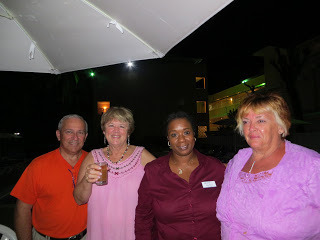
Vince, me, the manager, and Cugina
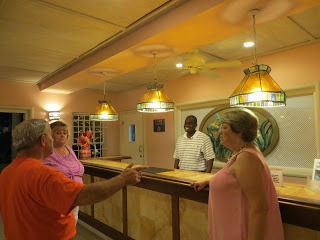
Jefferson was Employee of the Month andwe could see why.
Once again we head to The St. Lawrence Gap, this time to a restaurant that sits out on a pier of rock. Appropriately called Pisces, it’s a lovely place. We are led to a beautiful table that looks out at the harbour lights, where we can hear the waves lapping against the shore. It’s a stunning sight. We proceed to have the best dinner ever. It even tops Café Sol. Jamal comes to visit our table and the service could not be better. I have the most delicious sea food and Vince has a steak that he says was “worth the whole trip”. Wendy and Dennis ooh and ahh over their meals as well. Afterward we stroll the Gap a little bit. It’s a lot quieter tonight, though one “vendor” makes a quip that becomes one of our favourite lines: “I’m selling what you’re smelling.”

Oneal takes us up the hill on the way home, through another lively part of the Gap. Restaurants, bars, and hotels are lit up and lively. On a weekend it must be hopping. It seems that one day keeps topping the next.
Published on November 29, 2012 07:05
November 27, 2012
Barbados Blog 3: Jolly Rogering
Sunday, November 25 : Jolly Roger
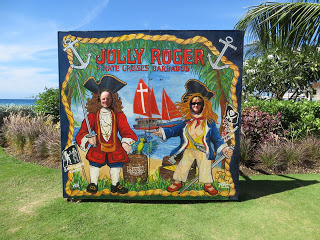
We have so much fun on the Jolly Roger that it’s difficult to recount everything. Luckily, I can tell the tale mostly through Wendy and Dennis's pictures.
When we first board, we find a spot in the shade and revel in the breeze once we set sail. It’s not very crowded and the rum punch is delicious right from the start. Not too far out, we anchor near a sunken ship. On go our masks and snorkels and we’re soon in the water, heads down, following a member of the crew who leads us to the spot. It’s quite windy and there’s a pretty strong current, but we kick through it until we’re on top of the relic. Beautiful striped, yellow and black, tiny blue, big pink fish, angle in and out of the sunken vessel below us. Schools of them seem to tickle our feet. I’ve never snorkeled over a ship before and I find it thrilling. I can see where the fish and the ocean have taken over and made our junk their home. Green moss and waving ferns make the rusting hunk almost beautiful.
Back on board, we continue the rum punch. A delicious buffet lunch is served, including my new favourite, macaroni pie. The group is revved up now, dancing on board, watching other sailboats cruise by, enjoying all the free sights and oh yes, the free booze.
My baby sister had reminded me this morning of the trip she took with our mom and dad years ago, on a Jolly Roger ship similar to the Black Pearl version we’re on. After a few rum punches, they began to neck, which really grossed her out. By the time I am finished this cruise, I want to bring my whole family with me. The kids would have a ball and the adults would become foolish and fun.
Our next stop is a snorkeling swim with the turtles. One of the crew brings a bag of fish that entices the huge turtles to come close. I stick close to him as he feeds one, then two, then a third little one. He is able to encircle one of them with his arms; she almost hugs him, then he coaxes her closer to me, where I can pat her head and feel her rocky shell. She blinks at me lazily, interested only in what there is to eat. It’s such a thrill.
Later we do all the crazy stuff. First, Dennis and I each walk the plank. When you get out onto the end of the board, it’s a bit wobbly, but you’re too embarrassed to turn back, so in you go. Now I can actually say it was fun! Next comes the rope swing. At first I’m too scared, but we’ve met a couple of women from New York, Maureen and Julie, and they talk me into it. That turns out to be a riot, too.The return sail is gorgeous: breezy, easy, and somehow everything is funny. We dance on the deck, laugh, Dennis and Wendy take tons of pictures. There’s even a revival of necking! An absolute blast is had by all.
Back at the hotel, we continue the laughter out by the deck, bob in the ocean, participate in happy hour and eat a terrific dinner. Arrrr, mateys, you gotta come to Barbados!
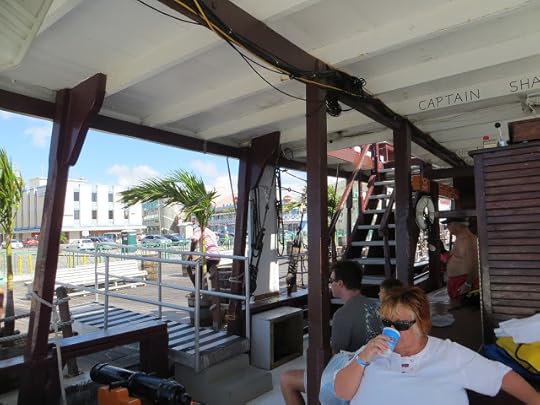 The rum punch is delicious!
The rum punch is delicious!
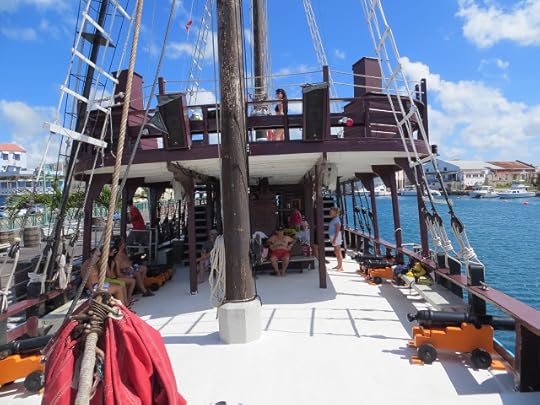 Our ship, The Black Pearl!
Our ship, The Black Pearl!
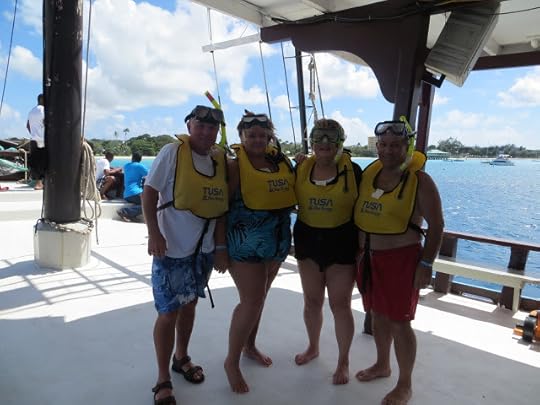 Ready for snorkelling!
Ready for snorkelling!
 Weren't the turtles magnificent?
Weren't the turtles magnificent?
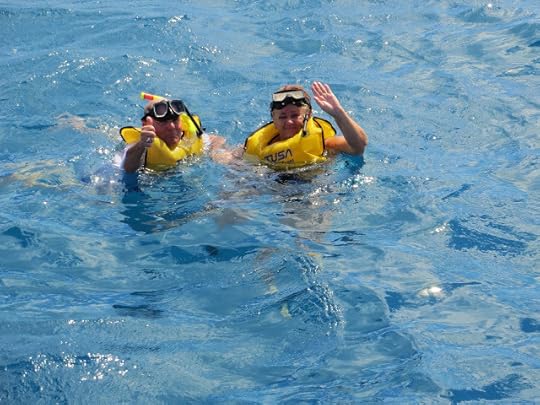 Wendy and Dennis loved it too!
Wendy and Dennis loved it too!
 Awesome! Beautiful! (The sea life, not me in a mask.)
Awesome! Beautiful! (The sea life, not me in a mask.)
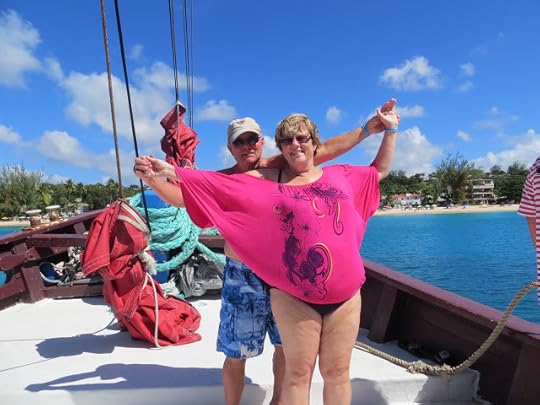 Queen of the world! Jack and Rose!
Queen of the world! Jack and Rose!
 Cuginas! (Or is it Cugini?)
Cuginas! (Or is it Cugini?)
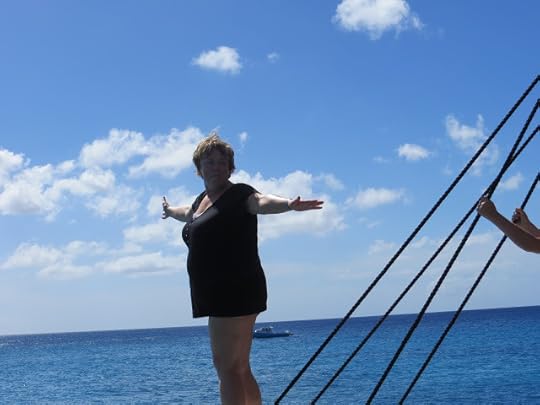 Walking the plank!
Walking the plank!
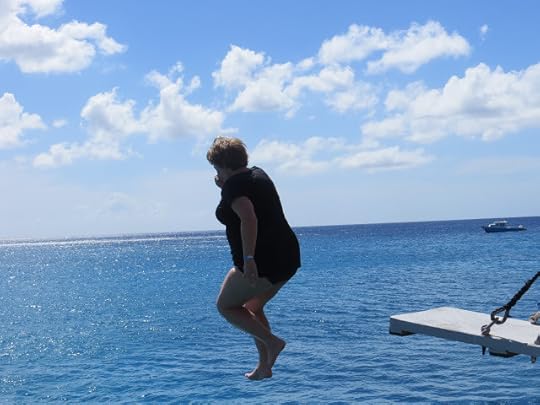 What kind of pirate holds her nose?
What kind of pirate holds her nose?
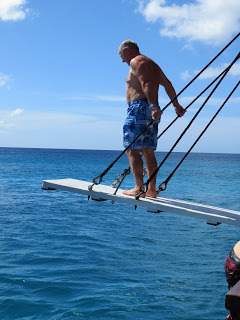 Dennis's turn!
Dennis's turn!
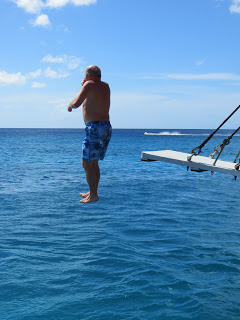 Another pirate who holds his nose!
Another pirate who holds his nose!
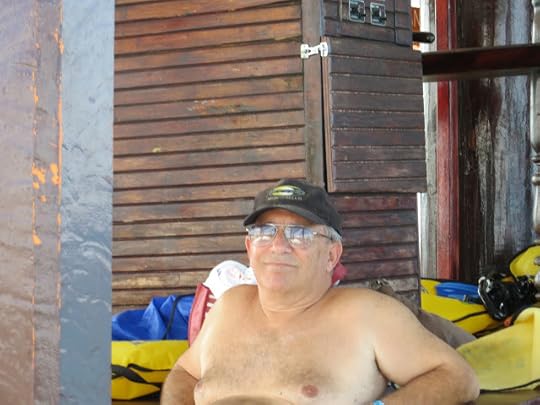 Laid back Vinnie: even he was feeling the punch!
Laid back Vinnie: even he was feeling the punch!
 Deck dancing!
Deck dancing!
 And singing...I am Canajun!
And singing...I am Canajun!


We have so much fun on the Jolly Roger that it’s difficult to recount everything. Luckily, I can tell the tale mostly through Wendy and Dennis's pictures.
When we first board, we find a spot in the shade and revel in the breeze once we set sail. It’s not very crowded and the rum punch is delicious right from the start. Not too far out, we anchor near a sunken ship. On go our masks and snorkels and we’re soon in the water, heads down, following a member of the crew who leads us to the spot. It’s quite windy and there’s a pretty strong current, but we kick through it until we’re on top of the relic. Beautiful striped, yellow and black, tiny blue, big pink fish, angle in and out of the sunken vessel below us. Schools of them seem to tickle our feet. I’ve never snorkeled over a ship before and I find it thrilling. I can see where the fish and the ocean have taken over and made our junk their home. Green moss and waving ferns make the rusting hunk almost beautiful.
Back on board, we continue the rum punch. A delicious buffet lunch is served, including my new favourite, macaroni pie. The group is revved up now, dancing on board, watching other sailboats cruise by, enjoying all the free sights and oh yes, the free booze.
My baby sister had reminded me this morning of the trip she took with our mom and dad years ago, on a Jolly Roger ship similar to the Black Pearl version we’re on. After a few rum punches, they began to neck, which really grossed her out. By the time I am finished this cruise, I want to bring my whole family with me. The kids would have a ball and the adults would become foolish and fun.
Our next stop is a snorkeling swim with the turtles. One of the crew brings a bag of fish that entices the huge turtles to come close. I stick close to him as he feeds one, then two, then a third little one. He is able to encircle one of them with his arms; she almost hugs him, then he coaxes her closer to me, where I can pat her head and feel her rocky shell. She blinks at me lazily, interested only in what there is to eat. It’s such a thrill.
Later we do all the crazy stuff. First, Dennis and I each walk the plank. When you get out onto the end of the board, it’s a bit wobbly, but you’re too embarrassed to turn back, so in you go. Now I can actually say it was fun! Next comes the rope swing. At first I’m too scared, but we’ve met a couple of women from New York, Maureen and Julie, and they talk me into it. That turns out to be a riot, too.The return sail is gorgeous: breezy, easy, and somehow everything is funny. We dance on the deck, laugh, Dennis and Wendy take tons of pictures. There’s even a revival of necking! An absolute blast is had by all.
Back at the hotel, we continue the laughter out by the deck, bob in the ocean, participate in happy hour and eat a terrific dinner. Arrrr, mateys, you gotta come to Barbados!
 The rum punch is delicious!
The rum punch is delicious! Our ship, The Black Pearl!
Our ship, The Black Pearl! Ready for snorkelling!
Ready for snorkelling! Weren't the turtles magnificent?
Weren't the turtles magnificent? Wendy and Dennis loved it too!
Wendy and Dennis loved it too! Awesome! Beautiful! (The sea life, not me in a mask.)
Awesome! Beautiful! (The sea life, not me in a mask.) Queen of the world! Jack and Rose!
Queen of the world! Jack and Rose! Cuginas! (Or is it Cugini?)
Cuginas! (Or is it Cugini?) Walking the plank!
Walking the plank! What kind of pirate holds her nose?
What kind of pirate holds her nose? Dennis's turn!
Dennis's turn! Another pirate who holds his nose!
Another pirate who holds his nose! Laid back Vinnie: even he was feeling the punch!
Laid back Vinnie: even he was feeling the punch! Deck dancing!
Deck dancing! And singing...I am Canajun!
And singing...I am Canajun!
Published on November 27, 2012 18:43
November 26, 2012
Barbados Blog 2
Itinerary: Saturday November 24thTour the island Part II – St. Nicholas Abbey Accra Beach BoardwalkDinner at Café Sol
This morning we find the remnants of last night’s rain – wet chairs, a ring of clouds and a strong breeze that tosses the waves around. We have a ball in the sea. I rent a boogie board and float up and down on the gentle swells and feisty white caps.
Originally, we planned to visit St. Nicholas Abbey, but it’s closed on Saturdays, so we have plenty to time. We decide to visit the exotic and well-known location of Nissan. That’s our car and we’re on the hunt for a hub cab. The dealer shows us the hubcap that’s supposed to fit our model, but it’s not the right one. Which is great, because they want $328 BB for one (about $170 US). Vince says we could buy a whole car for that. A tall, friendly Bajan who sat and listened to our conversations suddenly jumps up and says, “Follow me. I’ll get you a deal.” We look at each other, innately suspicious, and then figure, what the hell. Off we go behind our man’s van, through the clogged winding streets. He sometimes has to stop and wait for us. We visit two places with him, one down a dingy staircase into a basement shop, but they don’t have our style of hubcap. So he takes us to another establishment, a big, bright store that resembles Canadian Tire. Luckily, so do the prices. We pay $100 BB for FOUR hubcaps! We decide to keep them in the trunk for installation at the very end of the trip. Our guardian angel tells us his name is Charles. We give him a tip and thank him profusely. Then he leads us down toward the Boardwalk, where we want to take a walk and have lunch. Eventually we lose Charles, but we don’t lose the beach. Along the sturdy, wooden Boardwalk, we stroll beside the ocean. It’s beautiful.
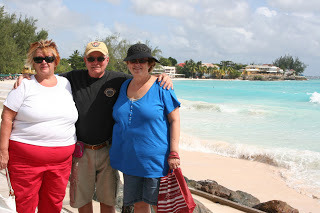
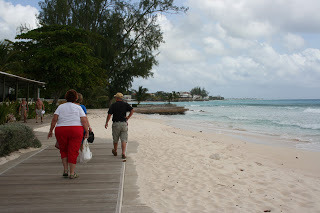 Here’s what the Costal Zone Management company says about it: “The Barbados Boardwalk on the south coast of the island was created amid some debate. There were concerns about the environmental impact on habitat, reefs and beaches, as well as the affect on homeowners along the proposed site. Several changes were made including making the boardwalk a few hundred yards shorter than planned. The end result is admired by Bajans and visitors who enjoy the new walk by the ocean. It is the first Barbados Boardwalk by the sea, complete with panoramas, seats and retreats. All ages and abilities use it. There are joggers, fast walkers, strollers, talkers and quiet people, wheelchairs, blind people, seniors, teenagers and babies in prams. The ambiance is friendly and respectful. Blending with the natural beauty, it is a solid structure set deep into the sand and bolstered with granite rocks. It looks like it is here to stay!”
Here’s what the Costal Zone Management company says about it: “The Barbados Boardwalk on the south coast of the island was created amid some debate. There were concerns about the environmental impact on habitat, reefs and beaches, as well as the affect on homeowners along the proposed site. Several changes were made including making the boardwalk a few hundred yards shorter than planned. The end result is admired by Bajans and visitors who enjoy the new walk by the ocean. It is the first Barbados Boardwalk by the sea, complete with panoramas, seats and retreats. All ages and abilities use it. There are joggers, fast walkers, strollers, talkers and quiet people, wheelchairs, blind people, seniors, teenagers and babies in prams. The ambiance is friendly and respectful. Blending with the natural beauty, it is a solid structure set deep into the sand and bolstered with granite rocks. It looks like it is here to stay!”We love it. The stronger wind keeps up, along with the clouds, so it’s comfortable to walk along even in the heat of midday. We discover the Accra Beach Hotel at the end and have lunch (the food is good, but the service is incredibly slooowww…even for Bajan time). We all agree that our hotel is better. The Butterfly is small, quaint, and has no activities or pounding music going all day – and we love that!
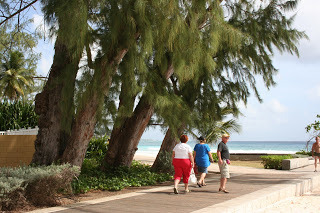
Afterward, we spend more time at the hotel, in the ocean and by the pool. There are three whirlpools too, that are not too hot, but feel like water massages. We spend a lot of time there, since it’s shady. We listen to a whistling frog and a bird who seems to be answering him back.
For dinner we head to Café Sol. It’s located in a lively, quaint area called the St. Lawrence Gap. The restaurant is small, but decorated with authentic Mexican memorabilia, and the food is outstanding. Not to mention it’s two-for-one on the sangria tonight. Later, we walk the Gap, looking at the lights shining on the water, gazing at the local crafts. We meet a man called John, who says he’s been on Canadian TV, playing the instruments he invented with every day utensils (like spoons). He sounds exactly like a bird when he plays one of them in his mouth. The temperature is perfect, the breeze cool on our brows, and the people strolling with us are all happy and friendly. A perfect evening.
Published on November 26, 2012 04:39
November 24, 2012
Barbados Blog
November 21-22-23
Itinerary: Wednesday November 21ArriveCab to HotelHappy Hour – dinner at our hotel
One of the moments I love best when I am travelling to warmer climes is stepping off the plane into the heat. A shawl of sea salt air covers me, kisses my head, pinches my skin. I breathe in the island: flowers, ocean, Bajan spices.
The voyage here was great; we snagged an emergency aisle with only two seats and we’re comfortable all the way. The ticket agent says we’re having a lucky day and she proves to be right.When we enter the terminal, I see Wendy (Cugina) across the hall and run for a hug. We’re so excited to be with my cousin and her husband Dennis, just the four of us, on a vacation. We’ve never done this before, except at the cottage, where they had to be our hosts. It’s Wendy’s 65thbirthday celebration and a late treat for their 45th wedding anniversary.
We hire a large taxi van and are soon barreling along the narrow streets. Colour floods my senses, blue and pink and yellow pastels. Our lodging is fairly small, which is wonderful, a soft pink and white, The Butterfly Beach Hotel. As we enter the reception area, we can see through to the turquoise water, little ripples of white caps and strands of navy blue.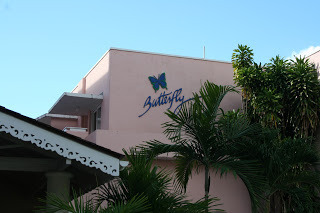
When we’re shown to our room, we have another surprise. We’ve been upgraded to a suite, with a living room, galley kitchen, and separate bedroom and bathroom. The balcony extends the whole length. It definitely is a lucky day. We think if only we were home, we might’ve bought a lottery ticket. We try to persuade Wendy and Dennis to switch rooms—it’s their party—but they refuse. Later, we think they made the right choice. Our living room is not air conditioned and the elevator doesn’t work, so we climb four times two sets of stairs even after eating or drinking too much, every time we go out or to the beach or the restaurant.
By three o’clock, we’re bobbing in the silky warm water. This is the most amazing sea we’ve ever been in, we say; even Maire would approve of the temperature. It’s an easy, lazy bay, the waves are gentle, swelling just enough to be interesting. The azure inlets are surrounded by white limestone rock and sand, dotted here and there with volcanic remains. We walk from the left to the right beaches, the plantation-style porch and restaurant above us, cross over a rocky formation, and I look back away from the sun to see my footsteps in the white sand.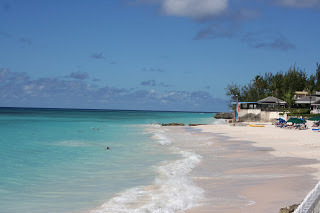
Barbados is a relatively young landform; it’s only a million years old. It was created when the Atlantic crustal and Carib plates crashed into one another under the ocean and threw up volcanoes of ash and rock. Because it was formed from two ecologies, unique plants and animals are found here. The first people, called Amerindians or Arawaks, arrived from Venezuela. Short, olive skinned, they wrapped infants’ skulls so they’d have a peaked head, and painted their skin white and black. Barbados’ history follows that of many desirable locations around the world. They were conquered, in turn, by the Caribs, Portuguese, Spanish, and finally, the English. One good thing about this checkered past is the remnants of varied traditions. For instance, the English brought sugar cane, which remains a big part of the Bajan economy. They also brought slavery, however, which was abolished in 1834. In 1966, Barbados gained its freedom from Britain, but is part of the commonwealth, just like Canada. There is lots of limestone, which explains the white sand and the azure colours.
Under the stars and a bright 3/4 moon, we have dinner at the beach restaurant on the hotel grounds. There’s a lovely breeze, which washes away the humidity. We have rum punch (sprinkled with nutmeg, a Bajan specialty) or cold beer (Banks is the local variety), sit and talk, listen to the waves punching the shore. This is the first time we hear the whistling frogs. Tiny little creatures, they hide among the trees and, well – wisso. Which reminds me, we meet Barbara and Antony from England, Monty Python’s homeland.
Itinerary: Thursday November 22ndCar delivery to Hotel 9 amTour the island Hollywood Beach (turns out to be Miami Beach, but we can’t find it, so we go to Mullins Beach)Dinner at Luigi’s an Italian favourite of oursSteel Pan entertainment at our hotel
Favourite sayings: “That’s gonna be a keeper” or “Another keeper” or “That’s a keeper” or “I’m gonna have to do so much erasing” and “Oooohhh, you must think the sun shines out your ass”.
We have breakfast at the hotel, still listening to the sea as we eat. The coffee is good, but the buffet leaves a little to be desired, so we decide to pick up groceries for morning meals.
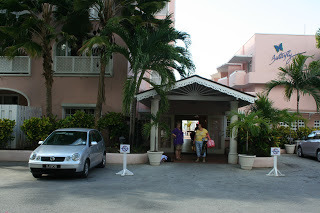 Our car is delivered shortly after nine a.m. Once again, we’ve been upgraded, this time to a larger Nissan. This proves to be both a gift and a curse.
Our car is delivered shortly after nine a.m. Once again, we’ve been upgraded, this time to a larger Nissan. This proves to be both a gift and a curse.
We take off on the narrow, clogged roads that remind us very much of Ireland with the vine-covered walls. Between the hotels and houses lining the streets, we glimpse the white sandy beaches and turquoise sea. We tour a bit of the island. When we’re thirsty, we turn down a narrow laneway and discover a bar. A beach bum tells us the rule is, “beer for breakfast, beer for lunch, rum for dinner”. It appears he follows the rule religiously.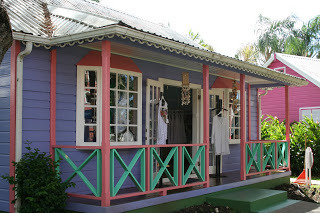
We shop at the Chattel House Village. These are quaint little homes that we see all over the island. In years past, the plantation workers built them and owned them, but didn’t own the land on which they stood. If they got fired or moved to another plantation, they had to be able to move their house too. So they’re small and, originally, sat on rocks with no foundations. Today, most of them have been cemented to the ground and enlarged, although there are many that are run-down and very tiny.
In the shopping Village, the homes are exquisitely painted blue, pink, white or yellow. Their gable roofs have been maintained and the fretwork looks like wooden lace. Their jalousie window shades were designed to be flexible in wind or rain, with three sets of hinges. I discover souvenirs adorned by an English painter who has lived here for fifty years. Her name is Jill Walker and her art is colourful and quaint, depicting Bajan life.
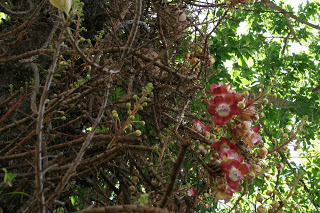 Inside the village circle, we stop by a gnarled tree whose roots curl upward, wrapping themselves around each other and the trunk like skeletal fingers. The flowers are little mustachioed faces. When the petals fall to the ground, they look like eyeballs. The gardener comes by and tells us this is the cannonball tree. He points to one of the cannon balls; it looks like a coconut, but it’s not edible. Used for medicinal purposes instead, they sound like cannons when they hit the ground.
Inside the village circle, we stop by a gnarled tree whose roots curl upward, wrapping themselves around each other and the trunk like skeletal fingers. The flowers are little mustachioed faces. When the petals fall to the ground, they look like eyeballs. The gardener comes by and tells us this is the cannonball tree. He points to one of the cannon balls; it looks like a coconut, but it’s not edible. Used for medicinal purposes instead, they sound like cannons when they hit the ground.
It’s all ire, mon, the sellers tell us, though we buy very little.
As we travel along, the sights are breathtaking. Boats; sails of red and yellow and orange; sun sparkling on the bands of light and dark blue sea; cabins with stone foundations; pastel coloured homes, some tiny, some giant, with soaring white pillars, plantation-style palaces. They vary between wooden structures and cement, stucco-covered buildings. Some are poor and achingly small, unpainted, stubby grass, few flowers, unemployed Bajans hanging over the porches. We wonder what the employment situation is here. There seems to be lots of building and road construction going on, but a great deal of poverty too. In some areas, the difference between one side of the street and the other is astonishing. Goats and horses feed on small grassy lots. The colours of the vegetable and fruit markets flash by in oranges and greens and reds.
We stop at Mullins Beach, where the real adventure begins. We can’t find a parking spot, so we impulsively swing into a small street and pull up at the curb. Here is upgraded, bigger car is not such a gift. It hugs the curb a little too hard and the hub cab tears right off. Despite the mini calamity, we have a great lunch at Mullins Restaurant, overlooking another gorgeous beach. There are lots of speedos here: and not always on speedo bodies. Wendy says an acquaintance of hers calls them budgie smugglers.
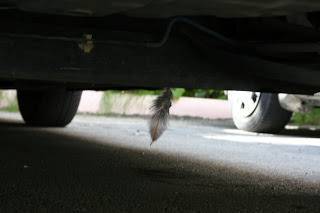 This time, Vince drives. As we roll along the narrow street, we spy, with horror, a rooster lying on the pavement. We’re not sure if he’s alive or dead, though Dennis swears he sees the little red head poke up just as we bump right over him. We drive back to the hotel with feathers in the chassis.
This time, Vince drives. As we roll along the narrow street, we spy, with horror, a rooster lying on the pavement. We’re not sure if he’s alive or dead, though Dennis swears he sees the little red head poke up just as we bump right over him. We drive back to the hotel with feathers in the chassis.
Not surprisingly, we decide to take a cab to Luigi’s for dinner. Oneal does a very good job and, when we tell him we’ll call him to return, he says to pay him then. Shades of Mexican trust! The meal is sumptuous. We’re soothed by soft winds and serenaded by whistling frogs. There are a lot of hub cab and rooster jokes.
Later, we enjoy the steel pan player at our hotel, along with more wine, rum or beer. The moon is up to 7/8ths. There’s a ring of clouds around the bay as though we are surrounded by a mountain chain.
Friday November 23rdWalk to Dover Beach (our beach is too nice, so we don’t do that)Concorde ExhibitLunch at Crane BeachHappy Hour at the hotelFish fry dinner at Oistins
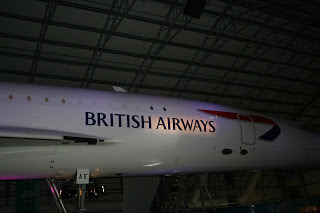 Vince and I sleep in – Cugina has to wake us! I swear it’s the booze and decide to have an alcohol-free day. Off we go to see the Concorde. All of us have an amazingly interesting experience, despite the fact that it’s Vince’s wish to go here. Brings back memories for Wendy and me; our fathers worked at Avro, and the Concorde’s wing style mimics the Arrow.
Vince and I sleep in – Cugina has to wake us! I swear it’s the booze and decide to have an alcohol-free day. Off we go to see the Concorde. All of us have an amazingly interesting experience, despite the fact that it’s Vince’s wish to go here. Brings back memories for Wendy and me; our fathers worked at Avro, and the Concorde’s wing style mimics the Arrow.
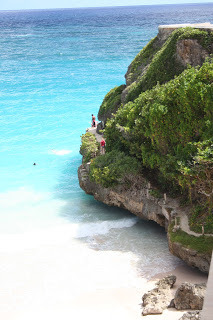
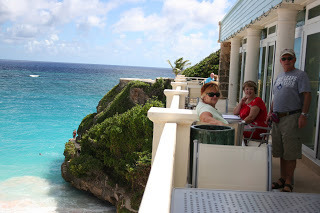
From there, we drive to Crane Beach and visit The Crane resort. What a spectacular place! We have lunch on a balcony high over the pink sand of the beach. Waves crash against the rocks. The scenery is breathtaking.
When we get back to the hotel, we swim in the ocean, sit in the whirlpools, and enjoy happy hour. We watch Mexican TV: the birds (frigates, pigeons, a heron), the vegetation (red and white primavera bushes, pink bougainvillea, green palms), the geckoes (a little one stalks and eats a fly). My alcohol-free day lasts until 3 p.m.
When the sun goes down, Oneal takes us to Oistins. We walk past the fish market, redolent with sea smells and the musk of fresh fish meat. The restaurants beyond this area are alive. Mostly locals, live music, fabulous food and even better rum punches. We have a wonderful meal, sway to the beats, do some touring of the craft stands, and Oneal takes us back home. What an experience, what a day!

Itinerary: Wednesday November 21ArriveCab to HotelHappy Hour – dinner at our hotel
One of the moments I love best when I am travelling to warmer climes is stepping off the plane into the heat. A shawl of sea salt air covers me, kisses my head, pinches my skin. I breathe in the island: flowers, ocean, Bajan spices.
The voyage here was great; we snagged an emergency aisle with only two seats and we’re comfortable all the way. The ticket agent says we’re having a lucky day and she proves to be right.When we enter the terminal, I see Wendy (Cugina) across the hall and run for a hug. We’re so excited to be with my cousin and her husband Dennis, just the four of us, on a vacation. We’ve never done this before, except at the cottage, where they had to be our hosts. It’s Wendy’s 65thbirthday celebration and a late treat for their 45th wedding anniversary.
We hire a large taxi van and are soon barreling along the narrow streets. Colour floods my senses, blue and pink and yellow pastels. Our lodging is fairly small, which is wonderful, a soft pink and white, The Butterfly Beach Hotel. As we enter the reception area, we can see through to the turquoise water, little ripples of white caps and strands of navy blue.

When we’re shown to our room, we have another surprise. We’ve been upgraded to a suite, with a living room, galley kitchen, and separate bedroom and bathroom. The balcony extends the whole length. It definitely is a lucky day. We think if only we were home, we might’ve bought a lottery ticket. We try to persuade Wendy and Dennis to switch rooms—it’s their party—but they refuse. Later, we think they made the right choice. Our living room is not air conditioned and the elevator doesn’t work, so we climb four times two sets of stairs even after eating or drinking too much, every time we go out or to the beach or the restaurant.
By three o’clock, we’re bobbing in the silky warm water. This is the most amazing sea we’ve ever been in, we say; even Maire would approve of the temperature. It’s an easy, lazy bay, the waves are gentle, swelling just enough to be interesting. The azure inlets are surrounded by white limestone rock and sand, dotted here and there with volcanic remains. We walk from the left to the right beaches, the plantation-style porch and restaurant above us, cross over a rocky formation, and I look back away from the sun to see my footsteps in the white sand.

Barbados is a relatively young landform; it’s only a million years old. It was created when the Atlantic crustal and Carib plates crashed into one another under the ocean and threw up volcanoes of ash and rock. Because it was formed from two ecologies, unique plants and animals are found here. The first people, called Amerindians or Arawaks, arrived from Venezuela. Short, olive skinned, they wrapped infants’ skulls so they’d have a peaked head, and painted their skin white and black. Barbados’ history follows that of many desirable locations around the world. They were conquered, in turn, by the Caribs, Portuguese, Spanish, and finally, the English. One good thing about this checkered past is the remnants of varied traditions. For instance, the English brought sugar cane, which remains a big part of the Bajan economy. They also brought slavery, however, which was abolished in 1834. In 1966, Barbados gained its freedom from Britain, but is part of the commonwealth, just like Canada. There is lots of limestone, which explains the white sand and the azure colours.
Under the stars and a bright 3/4 moon, we have dinner at the beach restaurant on the hotel grounds. There’s a lovely breeze, which washes away the humidity. We have rum punch (sprinkled with nutmeg, a Bajan specialty) or cold beer (Banks is the local variety), sit and talk, listen to the waves punching the shore. This is the first time we hear the whistling frogs. Tiny little creatures, they hide among the trees and, well – wisso. Which reminds me, we meet Barbara and Antony from England, Monty Python’s homeland.
Itinerary: Thursday November 22ndCar delivery to Hotel 9 amTour the island Hollywood Beach (turns out to be Miami Beach, but we can’t find it, so we go to Mullins Beach)Dinner at Luigi’s an Italian favourite of oursSteel Pan entertainment at our hotel
Favourite sayings: “That’s gonna be a keeper” or “Another keeper” or “That’s a keeper” or “I’m gonna have to do so much erasing” and “Oooohhh, you must think the sun shines out your ass”.
We have breakfast at the hotel, still listening to the sea as we eat. The coffee is good, but the buffet leaves a little to be desired, so we decide to pick up groceries for morning meals.
 Our car is delivered shortly after nine a.m. Once again, we’ve been upgraded, this time to a larger Nissan. This proves to be both a gift and a curse.
Our car is delivered shortly after nine a.m. Once again, we’ve been upgraded, this time to a larger Nissan. This proves to be both a gift and a curse. We take off on the narrow, clogged roads that remind us very much of Ireland with the vine-covered walls. Between the hotels and houses lining the streets, we glimpse the white sandy beaches and turquoise sea. We tour a bit of the island. When we’re thirsty, we turn down a narrow laneway and discover a bar. A beach bum tells us the rule is, “beer for breakfast, beer for lunch, rum for dinner”. It appears he follows the rule religiously.

We shop at the Chattel House Village. These are quaint little homes that we see all over the island. In years past, the plantation workers built them and owned them, but didn’t own the land on which they stood. If they got fired or moved to another plantation, they had to be able to move their house too. So they’re small and, originally, sat on rocks with no foundations. Today, most of them have been cemented to the ground and enlarged, although there are many that are run-down and very tiny.
In the shopping Village, the homes are exquisitely painted blue, pink, white or yellow. Their gable roofs have been maintained and the fretwork looks like wooden lace. Their jalousie window shades were designed to be flexible in wind or rain, with three sets of hinges. I discover souvenirs adorned by an English painter who has lived here for fifty years. Her name is Jill Walker and her art is colourful and quaint, depicting Bajan life.
 Inside the village circle, we stop by a gnarled tree whose roots curl upward, wrapping themselves around each other and the trunk like skeletal fingers. The flowers are little mustachioed faces. When the petals fall to the ground, they look like eyeballs. The gardener comes by and tells us this is the cannonball tree. He points to one of the cannon balls; it looks like a coconut, but it’s not edible. Used for medicinal purposes instead, they sound like cannons when they hit the ground.
Inside the village circle, we stop by a gnarled tree whose roots curl upward, wrapping themselves around each other and the trunk like skeletal fingers. The flowers are little mustachioed faces. When the petals fall to the ground, they look like eyeballs. The gardener comes by and tells us this is the cannonball tree. He points to one of the cannon balls; it looks like a coconut, but it’s not edible. Used for medicinal purposes instead, they sound like cannons when they hit the ground.It’s all ire, mon, the sellers tell us, though we buy very little.
As we travel along, the sights are breathtaking. Boats; sails of red and yellow and orange; sun sparkling on the bands of light and dark blue sea; cabins with stone foundations; pastel coloured homes, some tiny, some giant, with soaring white pillars, plantation-style palaces. They vary between wooden structures and cement, stucco-covered buildings. Some are poor and achingly small, unpainted, stubby grass, few flowers, unemployed Bajans hanging over the porches. We wonder what the employment situation is here. There seems to be lots of building and road construction going on, but a great deal of poverty too. In some areas, the difference between one side of the street and the other is astonishing. Goats and horses feed on small grassy lots. The colours of the vegetable and fruit markets flash by in oranges and greens and reds.
We stop at Mullins Beach, where the real adventure begins. We can’t find a parking spot, so we impulsively swing into a small street and pull up at the curb. Here is upgraded, bigger car is not such a gift. It hugs the curb a little too hard and the hub cab tears right off. Despite the mini calamity, we have a great lunch at Mullins Restaurant, overlooking another gorgeous beach. There are lots of speedos here: and not always on speedo bodies. Wendy says an acquaintance of hers calls them budgie smugglers.
 This time, Vince drives. As we roll along the narrow street, we spy, with horror, a rooster lying on the pavement. We’re not sure if he’s alive or dead, though Dennis swears he sees the little red head poke up just as we bump right over him. We drive back to the hotel with feathers in the chassis.
This time, Vince drives. As we roll along the narrow street, we spy, with horror, a rooster lying on the pavement. We’re not sure if he’s alive or dead, though Dennis swears he sees the little red head poke up just as we bump right over him. We drive back to the hotel with feathers in the chassis.Not surprisingly, we decide to take a cab to Luigi’s for dinner. Oneal does a very good job and, when we tell him we’ll call him to return, he says to pay him then. Shades of Mexican trust! The meal is sumptuous. We’re soothed by soft winds and serenaded by whistling frogs. There are a lot of hub cab and rooster jokes.
Later, we enjoy the steel pan player at our hotel, along with more wine, rum or beer. The moon is up to 7/8ths. There’s a ring of clouds around the bay as though we are surrounded by a mountain chain.
Friday November 23rdWalk to Dover Beach (our beach is too nice, so we don’t do that)Concorde ExhibitLunch at Crane BeachHappy Hour at the hotelFish fry dinner at Oistins
 Vince and I sleep in – Cugina has to wake us! I swear it’s the booze and decide to have an alcohol-free day. Off we go to see the Concorde. All of us have an amazingly interesting experience, despite the fact that it’s Vince’s wish to go here. Brings back memories for Wendy and me; our fathers worked at Avro, and the Concorde’s wing style mimics the Arrow.
Vince and I sleep in – Cugina has to wake us! I swear it’s the booze and decide to have an alcohol-free day. Off we go to see the Concorde. All of us have an amazingly interesting experience, despite the fact that it’s Vince’s wish to go here. Brings back memories for Wendy and me; our fathers worked at Avro, and the Concorde’s wing style mimics the Arrow.

From there, we drive to Crane Beach and visit The Crane resort. What a spectacular place! We have lunch on a balcony high over the pink sand of the beach. Waves crash against the rocks. The scenery is breathtaking.
When we get back to the hotel, we swim in the ocean, sit in the whirlpools, and enjoy happy hour. We watch Mexican TV: the birds (frigates, pigeons, a heron), the vegetation (red and white primavera bushes, pink bougainvillea, green palms), the geckoes (a little one stalks and eats a fly). My alcohol-free day lasts until 3 p.m.
When the sun goes down, Oneal takes us to Oistins. We walk past the fish market, redolent with sea smells and the musk of fresh fish meat. The restaurants beyond this area are alive. Mostly locals, live music, fabulous food and even better rum punches. We have a wonderful meal, sway to the beats, do some touring of the craft stands, and Oneal takes us back home. What an experience, what a day!
Published on November 24, 2012 04:32
November 18, 2012
My Own Family Mystery
Every Remembrance Day, I am reminded of my own family mystery (in addition to thoughts on war). The tale of my mom’s first husband wasn’t fully revealed until very recently. My mother was a product of her Irish parents’ habit of secrecy. (I say “was” here because dementia has changed all the rules.) You didn’t tell anyone a story unless you wanted all the neighbours to know. Thus skeletons remained firmly in their closets.
Mysteries were rarely solved. It seems ironic that I am a mystery writer now, going about solving all the puzzles.
When I was ten, my sixteen-year-old cousin told me that my father was not my dad. Of course at ten, a girl’s daddy is her hero, so I was wounded to the core. Pat showed me proof: a small, faded black-and-white photograph that featured a woman in a wedding dress with a man in a uniform. The only thing clear was my mother’s smiling face. Proof indeed.
That night, I flung myself onto my mother’s lap, sobbing, and through my tears managed to ask her if Dad was my real father. A trace of anger flashed in her eyes; she had to have figured out who the tattler was. But she reassured me that the timing was wrong: I would have to be sixteen, not ten, to be her first husband’s child. He had died in “the war”, she explained, and they’d had no children.
The only thing I knew about “the war” was that we got Remembrance Day off and my father and his brothers always paraded. Dad told us that, when Hitler found out he was coming, the dictator gave up and ended the battle. I even believed this tale when I was really young. So my real father was never sent overseas, unlike some of my uncles.
For many years, I forgot about the man my mother first loved. It was only when my sisters and I were packing her belongings for a move to a retirement residence that I discovered the photograph. This one was much larger than the copy Pat had shown me. It was an 8 by 10, sepia coloured, and very clear. This time, I could see that the man she had married was black.
In the 2000’s interracial marriage is not a big deal. In 1944, it probably was. I know this because I, a white Canadian, married a black Canadian in 1973 and it was a big deal then. In Canada we like to pretend we’re not prejudiced, but I could disabuse you of that notion by telling you my story – however, that’s not the point here. There’s also the issue of whether or not mom’s husband was in a segregated unit or not. He may have been “allowed” to fight alongside the whites by that time because enlistments were low.
The point is, my mother never told me. She never shared a thing about her first marriage, other than that they weren’t together very long before he was shipped overseas. However, the reality of his death had finally hit me, just as my mother’s memory was fractured by dementia.
I sent for the marriage certificate. His name was Lesley Darby. Now I could do some online research. Their union began on April 22, 1944, and poor Lesley Darby was dead by February 8, 1945. That was about all I knew. A young, handsome man, by the look of his picture, he lost his life on a nameless foreign shore.
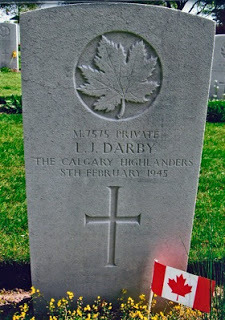
I began to pay a bit more attention to Remembrance Day celebrations, though. It feels odd to give thanks to a man for dying, not only for my freedom but also for my very existence.
A few years later, the Director of the retirement residence (Mom had moved on to long term care), contacted me and said my mother had left a package behind, one that gave the history of a Lesley Darby. She’d been sent the pictures of the cemetery because she was a sponsor in the past. Another secret…
Lesley died in the “battles of the Rhineland”, his body left cold and alone until moved to the Groesbeek cemetery in March of 1945, when all the dead were moved and buried in “friendly territory”. He was a member of the Calgary Highlanders, who held the front line at the beginning of December 1944.
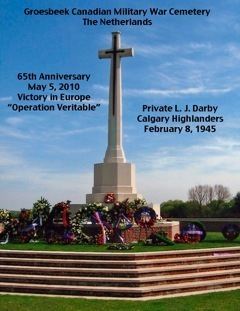 When I looked up the places on the map, they must have been at the border between The Netherlands and Germany. The strip where they fought and patrolled, mostly at night, was referred to as no-man’s-land. There’s a black-and-white, grainy picture of The Calgary Highlanders patrolling on December 4, 1944. The area looks bleak and bitter. “Accounts tell of mine fields and booby traps, mud and rain, frost and snow, dead and wounded.”
When I looked up the places on the map, they must have been at the border between The Netherlands and Germany. The strip where they fought and patrolled, mostly at night, was referred to as no-man’s-land. There’s a black-and-white, grainy picture of The Calgary Highlanders patrolling on December 4, 1944. The area looks bleak and bitter. “Accounts tell of mine fields and booby traps, mud and rain, frost and snow, dead and wounded.”Did my mother write him letters to keep him warm? I guess I’ll never know. Nor will we know exactly where he died, though the articles I have seem to imply that he was killed inside the German border and was brought back to Groesbeek (The Netherlands) for burial.
We have a coloured picture of his burial plot, and the directions to find it. Perhaps some day I’ll go there and visit. I’ll tell Lesley Darby how odd it feels to be thanking him for his sacrifice, since I am not only grateful for freedom, but for life.
Published on November 18, 2012 06:19
November 4, 2012
Laughing My Head Off
All the women in my family have huge laughs. We don't giggle like ladies. We literally laugh our heads off, bend our necks backwards, and guffaw.
Once, when my sisters and I attended a Second City improv, the comedian on stage used us in his routine as "cackling hens". That's really what we sound like.
Recently we attended a taping of Zoink'd, a children's show that my grandchildren love. My daughter and I sat further back, while the kids were placed up front for the cameras (all the kids were). Kristen and I fell in love with the warm-up guy, Josh Hellyer (watch him on his website and you'll see what I mean: The Josh Show). We laughed so loudly that we ended up making friends with him.
Any family party is suffused in such loud hilarity that we often disturb the neighbours. My friends are funny, too. There is nothing we love more than a joke or witty comment that sends us into gales of laughter. Sometimes the humour is fueled with alcohol, but still hilarious nonetheless. I love reading funny books too, such as my friend Melodie Campbell writes (Funny Girl Melodie).
So you would think that I would write comedy too. Instead, my books are filled with dark themes, complex characters, evil versus good, and that sort of thing. People look at me and wonder if I am a secret psychopath or something. They often can't believe that this benign, fun-loving middle-aged (OK, maybe 3/4 aged) woman writes such horror.
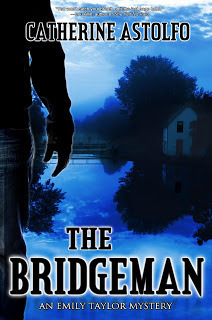 The Bridgeman
The Bridgeman
What they miss is the dichotomy. I pit violence against peaceful community, hatred with love, despair with hope. The good guys always win. The bad guys always get punished, even if that means some loss of innocence (or innocents) in the process. The world is always a changed landscape, but a better place in the end.
That's why I used the Ojibway philosophy of the Seventh Fire in my fourth book. The prediction states that the world will go through a terrible time that will change everything, but that people will emerge into a better place. Hell to heaven, if you will. Redemption perhaps. The Great Flood, the new start.
Really, when I think about my novels, they are demonstrative of my optimistic nature. They might not be LOL, but they are filled with hope, love, and strength of community. That surely befits a benign, fun-loving 3/4 aged woman. Catherine Astolfo
Once, when my sisters and I attended a Second City improv, the comedian on stage used us in his routine as "cackling hens". That's really what we sound like.
Recently we attended a taping of Zoink'd, a children's show that my grandchildren love. My daughter and I sat further back, while the kids were placed up front for the cameras (all the kids were). Kristen and I fell in love with the warm-up guy, Josh Hellyer (watch him on his website and you'll see what I mean: The Josh Show). We laughed so loudly that we ended up making friends with him.
Any family party is suffused in such loud hilarity that we often disturb the neighbours. My friends are funny, too. There is nothing we love more than a joke or witty comment that sends us into gales of laughter. Sometimes the humour is fueled with alcohol, but still hilarious nonetheless. I love reading funny books too, such as my friend Melodie Campbell writes (Funny Girl Melodie).
So you would think that I would write comedy too. Instead, my books are filled with dark themes, complex characters, evil versus good, and that sort of thing. People look at me and wonder if I am a secret psychopath or something. They often can't believe that this benign, fun-loving middle-aged (OK, maybe 3/4 aged) woman writes such horror.
 The Bridgeman
The BridgemanWhat they miss is the dichotomy. I pit violence against peaceful community, hatred with love, despair with hope. The good guys always win. The bad guys always get punished, even if that means some loss of innocence (or innocents) in the process. The world is always a changed landscape, but a better place in the end.
That's why I used the Ojibway philosophy of the Seventh Fire in my fourth book. The prediction states that the world will go through a terrible time that will change everything, but that people will emerge into a better place. Hell to heaven, if you will. Redemption perhaps. The Great Flood, the new start.
Really, when I think about my novels, they are demonstrative of my optimistic nature. They might not be LOL, but they are filled with hope, love, and strength of community. That surely befits a benign, fun-loving 3/4 aged woman. Catherine Astolfo
Published on November 04, 2012 07:19
November 1, 2012
Book Hugger?
When you see your beloved writers’ books on a shelf, how does it make you feel? I must admit that most of my favorite novelists are mystery authors, but I don’t think it matters what genre you like best. It’s all in the presentation, as they say.
I admit to being a book hugger. I still like the smell of the new paper, the feel of the cover (especially delicious if it’s raised print, oh my), and the sight of the words, colors, or designs that fill the package.
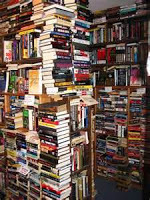 I do like my Kindle, don’t get me wrong. Ordering an ebook while I’m lying in bed with time to read is still a delight. My bookshelves are crowded and novels are falling off the edge, so refraining from adding one more is not a big deal.
I do like my Kindle, don’t get me wrong. Ordering an ebook while I’m lying in bed with time to read is still a delight. My bookshelves are crowded and novels are falling off the edge, so refraining from adding one more is not a big deal.But oh how I love to hug that book! Instead of the onus being on sight, all five senses are engaged. I flip through the pages, take a sniff, feel the silky sheets, study the cover, read the flap (or its equivalent) over and over again.
Thus if you are book hugger like me (not to mention that I am a paperback writer too): Dear Sir or Madam, will you read my book? It took me years to write, will you take a look? (stolen of course from The Beatles)
From November 1 to December 16, just in time for buying Christmas presents, my publisher is offering our books for $1 off the regular (already inexpensive) price. I promise my books are worthy of all your senses, from the fabulous covers to the delicious words.
You can find all the books at www.imajinbooks.com/sale
OR you can go to mine directly here:
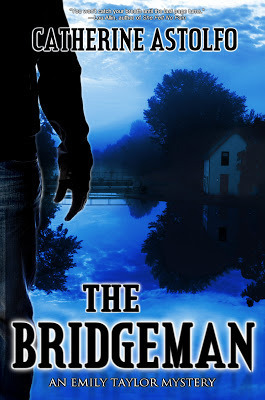
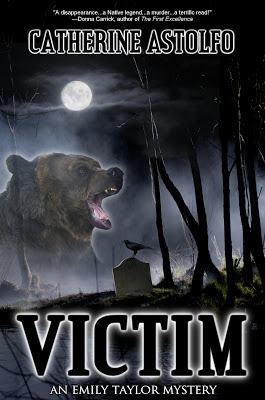
Coupon code HWVDU6SL at THE BRIDGEMAN
Coupon code HWVDU6SL at VICTIM
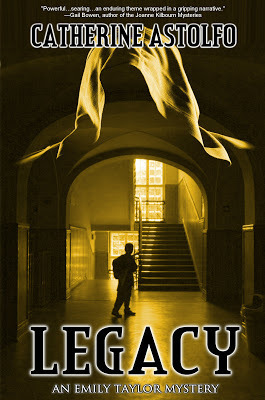
Coupon code HWVDU6SL at LEGACY
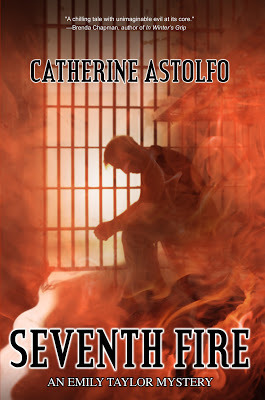
Coupon code HWVDU6SL at SEVENTH FIRE
Published on November 01, 2012 06:00
October 31, 2012
I think I'm in Love
There aren’t many things I dislike about my writing career, but I have to admit I am fond of the marketing side. There are probably some deep psychological reasons for this (writers tend to be sensitive, ya know), but the main explanation for me is that it take time. Time I could be spending on – well, writing.
Instead, I tweet tediously, blog blandly – I mean, beautifully - facebook frantically, link-in laboriously – all right, you get the picture.
Imajin my joy when I discover the Author Marketing Club through my publisher, Imajin Books! The site now has 3000 members. WAY more than I could reach in one fell swoop. And all they ask of me is a blog and a couple of links. I think I’m in love.

Fellow authors - go!
Book Marketing & Selling Tips For Authors
Published on October 31, 2012 09:12



